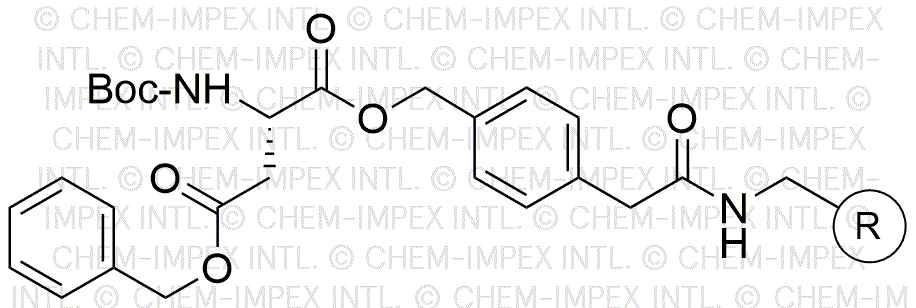Boc-L-aspartic acid b-benzyl ester 4-oxymethylphenylacetamidomethyl is widely utilized in research focused on:
- Peptide Synthesis: This compound serves as a key building block in the synthesis of peptides, particularly in creating modified amino acids that enhance the stability and bioactivity of therapeutic peptides.
- Drug Development: Its unique structure allows for the design of novel drug candidates, especially in the field of oncology and neuropharmacology, where targeted delivery systems are crucial.
- Bioconjugation: The compound is used in bioconjugation processes to link biomolecules, improving the efficacy of drug delivery systems and diagnostic tools.
- Research in Neuroscience: It plays a role in the study of neurotransmitter pathways, aiding researchers in understanding neurological disorders and developing potential treatments.
- Material Science: This chemical is also explored in the development of advanced materials, such as smart polymers that respond to environmental stimuli, enhancing their application in various industries.
General Information
Properties
Safety and Regulations
Applications
Boc-L-aspartic acid b-benzyl ester 4-oxymethylphenylacetamidomethyl is widely utilized in research focused on:
- Peptide Synthesis: This compound serves as a key building block in the synthesis of peptides, particularly in creating modified amino acids that enhance the stability and bioactivity of therapeutic peptides.
- Drug Development: Its unique structure allows for the design of novel drug candidates, especially in the field of oncology and neuropharmacology, where targeted delivery systems are crucial.
- Bioconjugation: The compound is used in bioconjugation processes to link biomolecules, improving the efficacy of drug delivery systems and diagnostic tools.
- Research in Neuroscience: It plays a role in the study of neurotransmitter pathways, aiding researchers in understanding neurological disorders and developing potential treatments.
- Material Science: This chemical is also explored in the development of advanced materials, such as smart polymers that respond to environmental stimuli, enhancing their application in various industries.
Documents
Safety Data Sheets (SDS)
The SDS provides comprehensive safety information on handling, storage, and disposal of the product.
Product Specification (PS)
The PS provides a comprehensive breakdown of the product’s properties, including chemical composition, physical state, purity, and storage requirements. It also details acceptable quality ranges and the product's intended applications.
Certificates of Analysis (COA)
Search for Certificates of Analysis (COA) by entering the products Lot Number. Lot and Batch Numbers can be found on a product’s label following the words ‘Lot’ or ‘Batch’.
Numéro de catalogue
Numéro de lot/série
Certificates Of Origin (COO)
This COO confirms the country where the product was manufactured, and also details the materials and components used in it and whether it is derived from natural, synthetic, or other specific sources. This certificate may be required for customs, trade, and regulatory compliance.
Numéro de catalogue
Numéro de lot/série
Safety Data Sheets (SDS)
The SDS provides comprehensive safety information on handling, storage, and disposal of the product.
DownloadProduct Specification (PS)
The PS provides a comprehensive breakdown of the product’s properties, including chemical composition, physical state, purity, and storage requirements. It also details acceptable quality ranges and the product's intended applications.
DownloadCertificates of Analysis (COA)
Search for Certificates of Analysis (COA) by entering the products Lot Number. Lot and Batch Numbers can be found on a product’s label following the words ‘Lot’ or ‘Batch’.
Numéro de catalogue
Numéro de lot/série
Certificates Of Origin (COO)
This COO confirms the country where the product was manufactured, and also details the materials and components used in it and whether it is derived from natural, synthetic, or other specific sources. This certificate may be required for customs, trade, and regulatory compliance.

